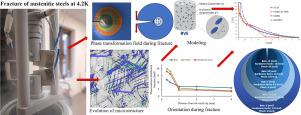亚稳材料在绝对零度附近断裂
IF 9.4
1区 材料科学
Q1 ENGINEERING, MECHANICAL
引用次数: 0
摘要
断裂是亚稳材料结构在极低温下完整性的关键问题之一。这类材料,特别是奥氏体不锈钢,在接近绝对零度时表现出延展性,显示出延性断裂的迹象。不锈钢在极低温度下表现出亚稳态行为,包括塑性应变诱导的fcc-bcc相变,导致由奥氏体基体和马氏体岛组成的两相连续体的产生。由于经典的断裂模型不包括相变,显然需要将断裂的描述扩展到多相材料。本模型采用Hencky-Ilyushin (H-I)变形理论框架下的大裂纹前应力场和应变场的Hutchinson解。在此基础上,建立了包含塑性应变诱导相变的模型,并给出了包含裂纹尖端前二次相分布的封闭解析解。并将解析解与缺口试样实验数据进行了交叉核对,试样在液氦(4.2K)中加载,直至断裂。显示了沿大裂纹轨迹积累次生相的证据。通过扫描电子显微镜(包括EBSD)进行的微观观察显示,当远离裂纹尖端时,显微组织发生了显著的变化,马氏体含量也在减少。分析模型与实验数据吻合较好,说明了解析解的有效性。本文章由计算机程序翻译,如有差异,请以英文原文为准。


Fracture of metastable materials near absolute zero
Fracture is one of the key issues for integrity of structures made of metastable materials operating at extremely low temperatures. A broad class of these materials, in particular the austenitic stainless steels, behave in a ductile way when strained near absolute zero, showing the evidence of ductile fracture. The stainless steels exhibit at very low temperatures metastable behaviour, consisting in the plastic strain induced fcc-bcc phase transformation, leading to generation of two-phase continuum composed of austenitic matrix and martensitic islands. As the classical models of fracture do not include the phase transformation, there is a clear need to extend the description of fracture to multiphase materials. The present model refers to the Hutchinson solution for the stress and strain fields in front of a macrocrack, obtained in the framework of the Hencky–Ilyushin (H–I) deformation theory. Based on this solution, a model including the plastic strain induced phase transformation is developed, and a closed form analytical solution including the distribution of the secondary phase ahead of the crack tip is presented. Moreover, the analytical solution is cross checked with the experimental data obtained for notched specimens, loaded in liquid helium (4.2K) until fracture. Evidence for accumulation of secondary phase along the macrocrack trajectory is shown. The microscopic observations, performed by means of a scanning electron microscope including EBSD, show significant microstructure evolution as well as decreasing martensite content when moving away from the crack tip. A fairly good agreement between the analytical model and experimental data was obtained, indicating the usefulness of the analytical solution.
求助全文
通过发布文献求助,成功后即可免费获取论文全文。
去求助
来源期刊

International Journal of Plasticity
工程技术-材料科学:综合
CiteScore
15.30
自引率
26.50%
发文量
256
审稿时长
46 days
期刊介绍:
International Journal of Plasticity aims to present original research encompassing all facets of plastic deformation, damage, and fracture behavior in both isotropic and anisotropic solids. This includes exploring the thermodynamics of plasticity and fracture, continuum theory, and macroscopic as well as microscopic phenomena.
Topics of interest span the plastic behavior of single crystals and polycrystalline metals, ceramics, rocks, soils, composites, nanocrystalline and microelectronics materials, shape memory alloys, ferroelectric ceramics, thin films, and polymers. Additionally, the journal covers plasticity aspects of failure and fracture mechanics. Contributions involving significant experimental, numerical, or theoretical advancements that enhance the understanding of the plastic behavior of solids are particularly valued. Papers addressing the modeling of finite nonlinear elastic deformation, bearing similarities to the modeling of plastic deformation, are also welcomed.
 求助内容:
求助内容: 应助结果提醒方式:
应助结果提醒方式:


